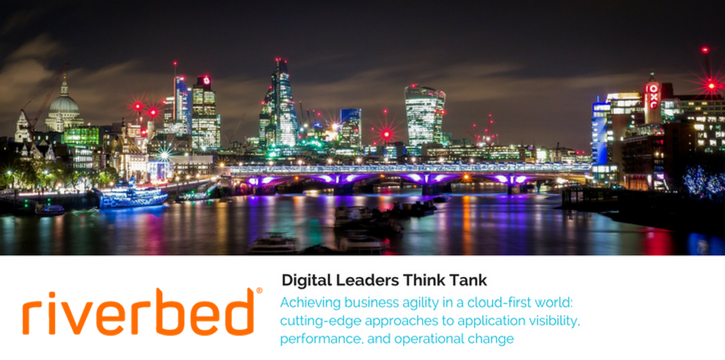The Digital Leaders Think Tank took place at Clements House, London, on 22 March 2018. It was held in partnership with Riverbed to discuss how to achieve business agility in a cloud-first world. Riverbed aims to deliver a complete view of your digital experiences throughout all your interactions with workers and customers.
Conversation topics included:
- What are the main challenges facing networking and infrastructure strategy within complex digital transformation programmes?
- How do you measure success?
- How do you measure and monitor the end-user experience throughout the digital transformation process?
Necessary Agility
From Blockbuster to black-cabs, linear television to book retailers; failure to disrupt and innovate has led to steep decline, social uproar, and even bankruptcy.
The lesson has been learned hard that failure to innovate and keep up with disruptors can leave incumbents vulnerable and exposed. This exposure that stems from the core competitive advantages of start-ups and SMEs: agility.
Not being weighed down by legacy systems and outdated practices start-ups and SMEs are places where strategies like 'fail fast' and sprint led-development are commonplace. They cultivate an agility that out-manoeuvres and disrupts the better funded, larger established businesses.
For the established companies the message has been clear, to keep our market position safe from disruption it is no good to be reactive. We need to change. We need to become ‘Agile’. The warning frequently voiced around the table: ‘if you don’t disrupt yourself, someone else will’.
Start-up Envy
It is unreservedly agreed upon that transformation is far more achievable when a company has a “lean mindset.” Large, established companies look to emulate the coveted “start-up ethos.”
Unlike established companies, start-ups are not dragged down by antiquated habits, heavy bureaucracy, and outdated waterfall risk-averse approaches. But approach the market in a naturally more agile way.
Start-ups can keep up with customers’ present consumptive needs and desires. For example Netflix’s disruptive streaming service met the consumer during the transition from the commonality of TV dinners and linear consumption towards the prevalence of binge watching an entire series.
The start-up can start at innovation point zero; they can meet the consumer immediately with the product they want in the way they want, while others have to steer their heavy organisational estate towards new consumer expectations, finding themselves behind at every step.
Start-ups also have a fundamentally different relation to risk. Able to quickly move from investment to R&D to minimum viable product, start-ups can innovate quickly and ‘fail fast’. The traditional path-dependant waterfall approach, followed by many established companies, entails drawn out bureaucratic and costly processes. It commits large amounts of resources to one potential innovation, with risk of being outdated by the time of delivery; inflating the cost of failure. This is in stark contrast to the joy of the fail-fast model where even failure is of value.
The final issue to compound these common risks lies in legacy systems. Established businesses are often tethered to antiquated programmes, data logs and inefficient processes that are obsolete in the face of new systems. The release of large companies from such systems is a complex and messy procedure. Issues surrounding the transferral of data and processes are worsened when fighting against entrenched workforce habits and a culture of resistance.
Faster Horses
The apparent lesson learnt from the start-up ethos appears clear. Move away from legacy systems, perform cloud-migrations, and move towards sprint-like transformation strategies and away from waterfalls. But it seems differences between SMEs and large enterprises run deeper than just ethos. Being successful like a start-up might not be as clear a definition as it first seems.
The question of measuring success is difficult within the context of digital transformation. Of course, a simple quantitative assessment of sales increase and profit gives some indication as to how successful a project has been. However, a far more holistic approach must be taken to measuring success. Profits and sales rely on consumer loyalty, which in turn relies on the experience of the end-user. A highly personalised, bespoke customer experience has become the benchmark now. Transformative digital projects must constantly strive to deliver an experience that matches the customer’s expectation and work towards new less clear metrics.
The nature of transformation is also ambiguous. It is a common mistake to implement only surface level transformation. After implementing cloud-migrations, software updates and new strategies and finally achieving agility; it can be tempting for companies to rest on their laurels as more efficient systems lead to larger profits at lower costs.
This can be a disastrous estimation. Often, fit and seemingly energetic organisations suddenly are disrupted by an innovative competitor, armed with new radical forms of old product. Whether it’s Skype, Airbnb, or Netflix; attaining radical disruption may require more than surface level agility.
It remains an open question as to how to avoid such superficial change. Some companies are investing in designated ‘innovation’ teams, boards and panels, assigned the role of identifying, approving and implementing disruptive and transformational strategies. Others rely on the brain power of a whole organisation, designing ‘innovation days’, wherein the entire workforce are taken off schedule to create divergent ideas.
A member summed up the trouble with disruption beyond agility, beyond obvious improvements towards real radical innovation, by the famous remark from Henry Ford:
‘If i’d asked people what they wanted they would have said a faster horse’.





Leave a Comment